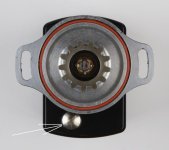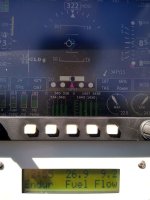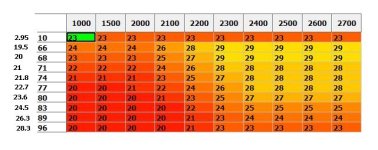Van's Air Force
You are using an out of date browser. It may not display this or other websites correctly.
You should upgrade or use an alternative browser.
You should upgrade or use an alternative browser.
Lycoming EIS vs Pmags
- Thread starter Rad8tion
- Start date
BOHICA
Well Known Member
This may seem like an odd perspective, but flip a coin and place the order.
Here's why. You're not going to get delivery for a while. In the meantime, you may change your mind, and just like avionics, new products will be introduced. Both systems will resell easily if you elect to make a change.
Pros and cons depend on many factors not identified (engine model, airframe wiring, etc). Most endorsements tend more toward tribal loyalty than rational reasoning. You best bet is to download both manuals and study them carefully....which may be another reason to just place the order and sort it out later.
Here's why. You're not going to get delivery for a while. In the meantime, you may change your mind, and just like avionics, new products will be introduced. Both systems will resell easily if you elect to make a change.
Pros and cons depend on many factors not identified (engine model, airframe wiring, etc). Most endorsements tend more toward tribal loyalty than rational reasoning. You best bet is to download both manuals and study them carefully....which may be another reason to just place the order and sort it out later.
I ordered my Lycoming back in July and selected the Lycoming EIS. Last month I got all the manuals and such from the sales person (Jeff). I started reading through them and realized that the Lycoming EIS only supports fixed timing. This pushed me over the edge and I deleted the EIS from my engine order and I'm planning to buy p-mags.
Rick_A
Well Known Member
Lycoming EIS vs Surefly
I was trying to figure out the difference between the Lyc EIS and the Surefly. They looked exactly the same to me. The last post clued me in.
Sure enough, the EIS install manual clearly states not to change the timing dip switches and that timing cover is sealed at the factory.
I guess if you want an EIS and variable timing, it would be better to order the Slick and replace it with a Surefly.
I was trying to figure out the difference between the Lyc EIS and the Surefly. They looked exactly the same to me. The last post clued me in.
Sure enough, the EIS install manual clearly states not to change the timing dip switches and that timing cover is sealed at the factory.
I guess if you want an EIS and variable timing, it would be better to order the Slick and replace it with a Surefly.
Carl Froehlich
Well Known Member
My recommendation - if you do anything other than a pMag (or Slick mag), create a dedicated power source for it. I suggest the standard “little backup battery” falls very short of the mark.
Carl
Carl
wcalvert
Well Known Member
Think it out
Dan, you continue to bring the voice of reason to these conversations!! Kudos
... Most endorsements tend more toward tribal loyalty than rational reasoning. You best bet is to download both manuals and study them carefully....
Dan, you continue to bring the voice of reason to these conversations!! Kudos
(Sigh)
Variable timing EIS is available for the 390-D in certified airframes. I'd be surprised to hear it can't be ordered for any of the experimental 390s.
However, if faced with a bureaucratic hang-up and variable EIS is desired, Plan A would be to delete ignition from the factory order and install the SureFly version.
Plan B: order fixed EIS, and practice civil disobedience. Ignore the certified rules and change the DIP switch settings. I doubt the cap can't be unscrewed. See the photo below.
Plan C: order a 23 degree fixed timing EIS via Lycoming. There is no performance to be gained between 23 and 30 degrees running a 390 ROP, or cruising at peak EGT (Lycoming's long-recommended setting) for speed. Running significantly LOP, high 20's timing will minimize the speed loss, but it will still be slower.
Along those lines, if selecting P-mags for a 390, pay close attention to jumper installation and installation clocking, or advance will be excessive.
-
Variable timing EIS is available for the 390-D in certified airframes. I'd be surprised to hear it can't be ordered for any of the experimental 390s.
However, if faced with a bureaucratic hang-up and variable EIS is desired, Plan A would be to delete ignition from the factory order and install the SureFly version.
Plan B: order fixed EIS, and practice civil disobedience. Ignore the certified rules and change the DIP switch settings. I doubt the cap can't be unscrewed. See the photo below.
Plan C: order a 23 degree fixed timing EIS via Lycoming. There is no performance to be gained between 23 and 30 degrees running a 390 ROP, or cruising at peak EGT (Lycoming's long-recommended setting) for speed. Running significantly LOP, high 20's timing will minimize the speed loss, but it will still be slower.
Along those lines, if selecting P-mags for a 390, pay close attention to jumper installation and installation clocking, or advance will be excessive.
-
Attachments
Just ordered 360 M1B….p mags. After reading much literature I decided that electrical systems can fail and I don’t want my ignition to die if that happens….EIS relies on power. I realise we have Altenator, battery and maybe even back up battery but the PMag option gives variable timing, electric operation or independent operation should power be interrupted.
Please correct me if I’m wrong. I’m a newbie.
Please correct me if I’m wrong. I’m a newbie.
Just ordered 360 M1B….p mags. After reading much literature I decided that electrical systems can fail and I don’t want my ignition to die if that happens….EIS relies on power. I realise we have Altenator, battery and maybe even back up battery but the PMag option gives variable timing, electric operation or independent operation should power be interrupted.
Please correct me if I’m wrong. I’m a newbie.
This was my thinking when I installed the pmags. They work fine. I strongly recommend getting either an enginebridge or eicommander so that you will have more information and control over your mags. And as DanH said, RTFM. You have to invest some time in this area. It's not magic, but it's really helpful to understand it.
BillL
Well Known Member
Not "fixed" timing , but not user selectable or knowable either.
From the SureFly website:
"For non-turbocharged engines, SureFly controls spark advance up to 38º before TDC as determined by manifold pressure and RPM (engine power setting). Each engine's base timing advance is read off the data plate and set into the SureFly Ignition Module or, "SIM" at installation. The timing advance schedule is hard set at the factory, when the SIM is manufactured, to provide the highest possible combustion efficiency."
Sure feels like "trust me", we know what is best for you, but more likely, to avoid fiddler issues and support workload resulting thereof. The whole philosophy of SureFly screams "no brainer, ease of installation". Although, no backup power seems lightly addressed IMO.
I am sure that one could (and someone will) bench mount a unit and document the timing schedule RPM vs advance vs MAP.
2 cents . . .
From the SureFly website:
"For non-turbocharged engines, SureFly controls spark advance up to 38º before TDC as determined by manifold pressure and RPM (engine power setting). Each engine's base timing advance is read off the data plate and set into the SureFly Ignition Module or, "SIM" at installation. The timing advance schedule is hard set at the factory, when the SIM is manufactured, to provide the highest possible combustion efficiency."
Sure feels like "trust me", we know what is best for you, but more likely, to avoid fiddler issues and support workload resulting thereof. The whole philosophy of SureFly screams "no brainer, ease of installation". Although, no backup power seems lightly addressed IMO.
I am sure that one could (and someone will) bench mount a unit and document the timing schedule RPM vs advance vs MAP.
2 cents . . .
scottmillhouse
Well Known Member
One Lycoming EIS experience
As others noted the EIS is fixed timing and you can only install one unless you have a backup electrical system. I got mine by a round about way. My factory Slick drifted timing substantially on my new engine and Lycoming would replace under warranty. They agreed to the EIS as an alternative but not a PMAG. No cross country trips yet so I can not judge any economy effect but it does start better especially on the dreaded fuel injected hot starts and there is less of a RPM drop on mag check.
As others noted the EIS is fixed timing and you can only install one unless you have a backup electrical system. I got mine by a round about way. My factory Slick drifted timing substantially on my new engine and Lycoming would replace under warranty. They agreed to the EIS as an alternative but not a PMAG. No cross country trips yet so I can not judge any economy effect but it does start better especially on the dreaded fuel injected hot starts and there is less of a RPM drop on mag check.
I am sure that one could (and someone will) bench mount a unit and document the timing schedule RPM vs advance vs MAP.
Yes. It's reasonable to assume Lycoming sets the 390D's base timing at 20, but I remain curious about maximum advance at altitude.
For a 390, I wouldn't take the variable version anyway. Might save a little fuel by cruising in the 8 GPH ballpark, but it will still be slower and hotter than running in the low 9's. Parallel valve is a different story.
Below was yesterday, on the way to lunch, fixed 23 degree timing, peak EGT. 66%, 187 TAS, 9.2 GPH. About 30 sq inches of cowl exit area, roughly half that of a stock RV-8. Cuts drag, but pushes CHT up a little.
Note the difference in operating philosophy. In theory, we can add ignition advance and pick up power, while accepting higher CHT. Or we can use mild ignition timing, but cut cooling airflow, resulting in the same CHT. I choose the latter because it reduces mechanical stress (lower peak cylinder pressure), and cuts drag.
BTW, I have two onboard maps, one fixed, one advancing, selectable with the flip of a switch. At 22/2450 the advancing schedule (below) triggers at about 28 BTDC...but the airplane doesn't go faster.
.
Attachments
AWeingram (RV14)
Member
I ordered my engine about a week ago. Thunderbolt EXP 119
I went with the Dual E mags after talking to the lycoming guy. As I understood it they will install 2 and they will do the advance thing at altitude and they are self contained units.
But after a back and forth with him, (I was hemming and hawing and basically being lazy by not doing much research myself yet) I went with that because they were self contained units.
Unless I mis understood him, I think I'll get the LOP at altitude advantages without having to have backup electrical for it and I'm good to go.
Cheers
Andrew
I went with the Dual E mags after talking to the lycoming guy. As I understood it they will install 2 and they will do the advance thing at altitude and they are self contained units.
But after a back and forth with him, (I was hemming and hawing and basically being lazy by not doing much research myself yet) I went with that because they were self contained units.
Unless I mis understood him, I think I'll get the LOP at altitude advantages without having to have backup electrical for it and I'm good to go.
Cheers
Andrew
Unless I mis understood him, I think I'll get the LOP at altitude advantages without having to have backup electrical for it and I'm good to go.
Be sure to clock the base timing and install the jumper in order to limit total advance. Or install some sort of controller, Engine Bridge, EI Commander, etc.
If truly LOP, ballpark 8 to 8.5 GPH at ~60%, 28 BTDC will gain 2, maybe 3 knots compared to base 20 BTDC. This "fuel saver" mode is pretty much the entire payoff to a P-mag on a 390, and then only if clocked so total advance is limited. Move to 23 fixed vs 28 advanced, and the spread gets less. As previously noted, advance brings higher peak pressure and higher CHT.
Below, really good data from Marvin McGraw, 23 vs 28 timing with an SDS equipped 390 in a well built RV-14. For clarity, I've cropped out everything but peak EGT, 25 LOP, and 50 LOP. My own tests have not been as detailed as Marvin's (the SDS system allows him to try any number of advance settings on the same flight, while I can only try two), but results have matched.
.
Attachments
Last edited:
Lycoming Dual EIS
For what it's worth. I had similar questions about wether the Lycoming EIS (Surefly Ignition) had variable timing and I called Lycoming and talked to a rep. He had me read the the engine designation from the order page: EA YENPL-RT2V11172. He told me that that engine has variable timing implemented (perhaps that's what the "V" means).
For what it's worth. I had similar questions about wether the Lycoming EIS (Surefly Ignition) had variable timing and I called Lycoming and talked to a rep. He had me read the the engine designation from the order page: EA YENPL-RT2V11172. He told me that that engine has variable timing implemented (perhaps that's what the "V" means).
And for another set of data, not nearly as scientific and detailed as others, I now have a combine of over a 1000 hours on PMAGs, RV7 with IO360, RV14 with IO390 and now with IO390EXP119 and all with very satisfactory result.
To start with, I echo Dan's advise/warning on setting the timing/clocking the PMAG correctly for the IO390 engine.
One of my aim has been to get the best fuel economy for the speed and as part of that, I used EI and tuned fuel injector nozzles. My last RV14 did really great high up, 15-17K MSL and currently I have been gathering data with the EXP119 engine. Of course the cowl flap helps as well but I can close it only high up as lower altitude will raise my oil temp more than I like to see. CHT in IO390 has not been any issues at all. I am just about ordering a set of nozzles and once the plane is back from the paint shop, I should be able to provide more data on that.
To start with, I echo Dan's advise/warning on setting the timing/clocking the PMAG correctly for the IO390 engine.
One of my aim has been to get the best fuel economy for the speed and as part of that, I used EI and tuned fuel injector nozzles. My last RV14 did really great high up, 15-17K MSL and currently I have been gathering data with the EXP119 engine. Of course the cowl flap helps as well but I can close it only high up as lower altitude will raise my oil temp more than I like to see. CHT in IO390 has not been any issues at all. I am just about ordering a set of nozzles and once the plane is back from the paint shop, I should be able to provide more data on that.








